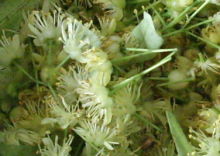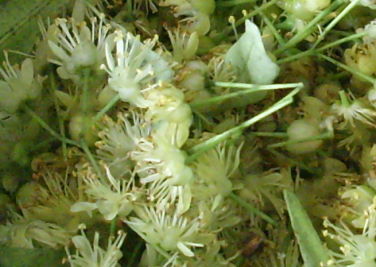Lime Flowers
By Mike on Saturday, July 12, 2008, 09:36 - Permalink
 Lime trees are full of fragrant blossom here in the south of England.
Lime trees are full of fragrant blossom here in the south of England.
What Are Lime Trees?
Tilia spp - also known as Linden or Basswood in some parts of the world - these are not the well-known Citrus limes, but an unrelated family of temperate zone deciduous tree.
The trees are often planted in parks and by roadsides - they form a rounded to tall conical shape with deeply green, asymmetric heart-shaped leaves that cast a deep, cool shade.
 The flowers are little starry greenish-white pom-poms dangling in clusters on slender stalks attached to a tongue-shaped papery bract. They're powerfully fragrant and their perfume can carry on the breeze for quite a distance.
The flowers are little starry greenish-white pom-poms dangling in clusters on slender stalks attached to a tongue-shaped papery bract. They're powerfully fragrant and their perfume can carry on the breeze for quite a distance.
The scent is sweet and floral, but at the same time, fruity and reminiscent of ripe melon or peach.
Picking Lime Flowers
Picking the flowers can be tiring work, as they're usually mostly above head height and are distributed quite sparsely about the tree. A stepladder may prove useful in reaching the good ones.
It's not uncommon for the trees to be absolutely crawling with aphids and other insects, in which case it may not be worth picking anything - unless you don't care about consuming them - a few bugs can be just shaken off the flowers as they're gathered, or picked out later, but heavy infestations can make it impossible.
The Leaves
Up until the about time of flowering the fresh young leaves of the lime tree are edible and supposedly quite tasty - suitable for use in salads and sandwiches. I have yet to test this, as the leaves are hugely popular with insects too and are often shredded or nibbled by insects, covered in galls, or coated with sticky honeydew excreted by aphids, and I've had trouble finding any in a condition I'd describe as appetising.
A Chocolate Substitute?
I read somewhere that someone had claimed to be able to manufacture a substitute for chocolate by grinding together the dried flowers and dried, hard fruits of the lime tree.
This sounds intriguing - I don't expect for one moment it will really be anything like chocolate (I have a feeling it was in a book about wartime rationing - the same book had a tip on using parsnips as a banana substitute - so you can perhaps understand my scepticism), but still, I'll have to try it sometime...
In The Kitchen
Lime flowers are reputed to have calming properties and a tisane can be made by simply steeping a handful of fresh flowers in a cup of hot water for a few minutes. I can't vouch for the calming/soporific effects, but it's a splendid drink anyway - pale green, and perfectly capturing the delicious fragrance of the flowers.
Lime Flower Fizz
Everyone else is making elderflower fizz this summer - it's a mildly alcoholic young wine that is activated by yeasts naturally occurring on the flowers and is bottled and corked securely while still actively fermenting - the Carbon dioxide produced by the yeast cannot escape, so it goes into solution, making the resulting drink fizzy.
I decided to be different and make the same thing, but with lime flowers.
I picked about a pint of flowers.
I spread them out on a tray - this makes it easier to pick out any foreign bodies (including living, crawling ones)
I dissolved a (guessed)few ounces of sugar into a couple of pints of water in a clean plastic bottle, added a chopped and crushed lemon and pushed in all the flowers
I capped the bottle loosely and left it alone for a couple of days...
...after which time, it was clearly fermenting quite actively - despite only capping loosely, there was still an exuberantly percussive whooshing sound when I released the lid - and I noticed that the indented handgrips on the bottle had been pushed partly inside out by the pressure.
The flowers had infused some of their colour and flavour into the water - the smell was pleasant and faintly alcoholic. I strained the liquid twice and put it into a couple of clean, empty Groslch bottles with ceramic stoppers
The fermentation process from now on should build up lots of pressure inside the bottles - this will either cause the drink inside to become delightfully sparkling, or it will make the bottles explode violently. because of this unknown, I have placed them in a plastic bucket inside the wooden box I've made to serve as a single-use kiln for one of my other projects.
Lime Flower Fizz - The Results
I waited patiently for a whole week - the bottles didn't explode, so I opened one up - the stopper opened with a reassuring pop, and the contents bubbled - nearly overflowing - so the fizz part of the project was definitely a success. The beverage is a light golden colour - not entirely clear, but I don't think that's unusual for a brew of this type - it looks like this:
The Taste
The taste is quite pleasant - sweet with a pleasant flowery bouquet - nicely sparkling and with a subtle, but definite gingery tang - this must have come from the flowers or stalks, as I added only sugar, water, flowers and lemon.
It could do with a little more acidity - so I'll add more lemon juice next time, or just squeeze a fresh wedge in the glass before serving, but all in all, I'd say this experiment has been a success.
Drying Lime Flowers
The flowers have quite a short season, but can be dried for use later - someone on the River Cottage Forum suggested strewing them on cardboard egg trays to dry. I didn't have any of these, so I put them on a sheet of kitchen paper in an old margarine tub - they will dry in about a week in a warm, airy place - but out of direct sunlight.
They shrivel a little when drying, but retain most of their scent. I've dried about a couple of handfuls, which I intend to use for the Linden Chocolate experiment.
More On Lime As A Chocolate Substitute
I dug out the reference to this in my books - it was apparently a French chemist named Missa who discovered that the dried flowers and fruits of the lime tree produced a substance tasting like chocolate when ground together. For a brief period, 'Linden Chocolate' was manufactured and sold commercially, but did not take off owing to poor keeping qualities.
I tried testing this idea for myself - the results are on the next page.
